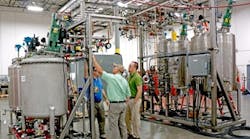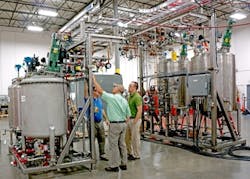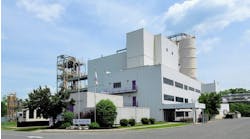Securing funding for your pilot plant can often be the most difficult obstacle to overcome when scaling up your process technology. While a pilot plant generally serves as a key stepping stone in taking a process from bench scale to full production, there usually still is strong pressure to minimize its cost. However, by skimping too much on the funding, you may build a pilot unit that does not give enough useful data for the construction of a production plant.
On the other hand, keeping costs reasonable could make the difference between your project getting cancelled or delayed due to capital restraints and smoothly moving through the capital approval process. This article will cover eight factors to consider when determining areas for cutting costs while developing your pilot plant.
Always keep in mind the goals of your particular project when considering this list. These factors often involve tradeoffs. Having a clear priority on what outcomes you need will determine which areas you can re-evaluate and which are set in stone.
Figure 1. Off-site fabrication can improve the quality of pilot-plant elements and also compress the project schedule.
Evaluating Pilot Plant Costs
To get a better handle on the potential costs of your pilot plant, review your project and assess each of the following factors:
1. Operating cost. Can you shift capital cost to operating cost? Because a pilot plant is a temporary operation, you could get by with less automation and more manual operator intervention. This can significantly reduce both instrumentation and equipment cost but might demand more attention from operators to keep the pilot plant running. Just be careful not to sacrifice the robustness of your overall system. People can be inconsistent and potentially can act as a new source of process upsets, increased transient states, or required startups and shutdowns.
[callToAction ]
For example, imagine a production-scale plant will be processing 120 mt/day of a dry flowable bulk solid. At production levels, this will require extensive solids-handling equipment including truck unloading, silos and conveyance. However, at a pilot level, you probably wouldn’t need full-scale solids-handling equipment and might get by with an operator with a shovel. Often solids-handling issues are well understood and so reducing equipment and using labor can save money with little risk. In a full-scale facility, solid handling isn’t trivial and still can pose unwelcome surprises. For tips about dealing with solids, see CP’s Solid Advice column. Purchase smaller, less expensive equipment to fully vet the technology or, depending upon run time, it might make sense to have an operator manually load a hopper.
2. Required production rates. When deciding upon the production rate of your pilot plant, you must strike a balance between cost and accuracy. Will your pilot plant reflect operating conditions of full production and to what degree? A 1,000:1 difference between production and pilot rates is too big to give much confidence in most situations. A 2:1 ratio provides an immense amount of confidence but would be a waste of money. Good engineering judgment and cost/benefit analysis are critical when making this choice.
It’s wise to keep in mind areas where a professional can assist. Knowing which unit operations are most likely to change with scale and how to combat this is key. For instance, if you have a packed-bed reactor with a heat-transfer jacket, a smart decision would be to choose a defined tube diameter and length. You would then use your pilot plant to vet this fixed tube diameter and length with a single large tube. The full-size production scale might require 150 tubes, but each individually should function exactly like the one in the pilot plant. This will give everyone involved a high confidence around the reactor.
3. Materials of construction. You might be able to economize by using a material that has a “good” or “fair” rating, based upon the particulars of your process and how long the pilot plant needs to run. The best way to confidently make this call before building the pilot plant is via coupon testing at lab scale.
Additional coupon testing in your pilot plant for production-grade equipment can also contribute to long-term savings. This helps ensure that any materials tradeoffs you might be considering won’t raise glaring issues. Nearly identical materials can lead to drastically different outcomes.
4. Instrumentation. If the data gathered won’t change any design decisions or refine any selections, it might not be worth the cost to install instrumentation for measuring these data. It is natural to want as much instrumentation as you can get on your pilot plant — but you must balance that desire with cost. Knowing which measurements are critical and which just fall into the “nice to know” category is imperative.
Depending upon the unit operations used, instrumentation can vary from 25% of the overall cost of a pilot plant to much more than the cost of the rest of the equipment combined. Keeping this number in check is critical but you still must ensure the pilot gathers all the data required for vetting the full-sized facility.
5. Location. If possible, locating your pilot plant on a site with existing utilities almost always is an excellent decision. It is doubly so if required raw materials for your process already exist there. However, check the air and water permits, especially if your process might alter an existing permit. Updating these permits not only incurs a cost in staff time but also can lead to non-trivial schedule delays.
6. Modular fabrication. First, you must determine if modular fabrication makes sense. Off-site construction at a fabrication facility (Figure 1) helps compress project timeline, ensure quality manufacture inside a controlled environment, and reduce the total number of craftsman hours worked on site, which cuts the chances of accidents.
Shop-fabricated modules offer additional advantages. The controlled fabrication environment means no delays due to inclement weather as well as a higher quality product because every weld is made in ideal conditions. Moreover, it avoids the need for plant personnel to get a general and hot-work permit every day. More of every craft labor hour you’re paying for is spent making progress on your project. This faster installation means less downtime in existing operation units and a speedy return of your facility to making product.
In addition to quality and safety improvements, the schedule compression comes from the ability to concurrently perform any required site work and fabrication as opposed to waiting for the site work to be completed before starting fabrication. Completed skids are fabricated offsite and fully tested, arriving at your plant ready to attach to utilities and come online. (For more on this option, see “Consider Modular Pilot Plant Construction.”)
7. Existing processes. Are you reinventing the wheel? It is important to refrain from wasting time by testing parts of the process that are clearly established. Instead, focus only on those elements required for validating your technology.
If a portion of your production facility uses a mature well-understood technology, then excluding that technology may make sense. This can involve everything from using CO2 from bulk tanks instead of scrubbing flue gas, burning syngas instead of feeding it into a second process, or not purifying your final product.
The closer you can get to matching how something is used in the process, the greater degree of confidence you should have in excluding it. If you’re starting with the same raw materials and only performing the first half of your process, you’re likely to be on sound ground. However, if you’re starting point is an intermediate, then you may face a lot of risk depending upon how close the approximation is to the actual intermediate. In the case cited above of using bulk CO2 instead of actual flue gas, you must carefully consider any possible contaminants that might carry over from the flue gas (e.g., soot, CO, NOx and SOx). Finding out after the fact that a ppm-level contaminant is slowly and steadily poisoning your catalyst would make for a terrible start to your brand-new plant.
8. Process robustness. Certain unit operations and pieces of equipment tend to scale more easily. The more subtle and sensitive a unit operation is, the more difficult it is to scale. In moving from lab- to pilot-plant scale, see if you can break down an operation into multiple steps that individually are more forgiving. This should make your overall process more robust and repeatable.
Depending upon the equipment being replaced, this technique could increase or decrease costs, but it should always yield a more reliable process. For example, can a reaction step that is sensitive to having the stoichiometrically perfect amounts of reactants achieve the same end results by instead running at a huge excess of one reactant with a subsequent stripping step? While taking two steps for something that could be done in one may seem inelegant, the change may provide substantial gains in reliable data collection and process repeatability.
Consider The Options
While general guidelines do not work for every project, reducing pilot plant costs is possible. Combine the advice in this article with good engineering sense about your own technology. Also, consider getting an engineer with experience in pilot-plant design to assist in deciding where it makes the most sense to reduce costs for your project. Plant design partners should bring extensive knowledge of what works and what doesn’t work at a plant level and a pilot level, which you then can marry with your knowledge of your exact technology for the best outcome.
STEPHEN BENBROOK is a process development engineer for EPIC Systems, Inc., St. Louis, Mo. Email him at [email protected].



